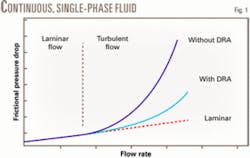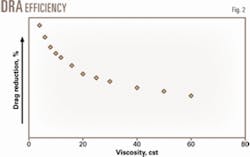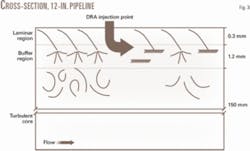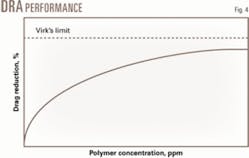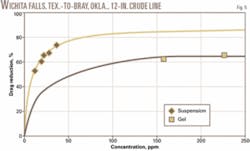Suspension-based drag-reducing agents (DRAs) have proven to be an alternative to gel-based technology for ConocoPhillips Pipeline Co.’s US crude pipelines. This article examines data from one of Conoco’s pipelines in addressing the relative advantages of suspension-based (vs. gel-based) DRA technology.
When added to pipelines or conduits, DRAs typically perform one of two major tasks:
- Reduction of energy consumption where the same target throughput is accomplished with less pumping power.
- Increased throughput of the fluid in the pipeline by use of the same pumping power that was used before addition of the DRA.
Fig. 1 illustrates the effect of treating a continuous, single-phase fluid in a conduit. The pressure drop of a fluid in laminar flow increases linearly as flow rate increases, but in turbulent flow, a more significant increase in pressure drop appears as flow rate increases.
Adding a DRA, however, can minimize the pressure drop of the same fluid in a conduit at a given flow rate, allowing it to be pumped with less energy.
Drag reduction
In a pipeline, a fluid moves in one of two types of flow: laminar or turbulent. Laminar flow exists with no deviation in velocity in the direction of flow, and turbulent flow exists with local deviations in velocity relative to the bulk flow of the fluid.
Crosscurrents and eddies cause the velocity deviation in turbulent flow. This causes the fluid molecules to move randomly, wasting a significant portion of the applied energy used to move the fluid.1
Four major factors govern the flow regime of a fluid in a pipeline: pipe diameter, fluid density, fluid viscosity, and the average velocity of the fluid. The transition from laminar to turbulent flow is governed by the dimensionless group called the Reynolds number (NRe). The following equation calculates the Reynolds number:
where: D = pipe diameter; V = average velocity of the fluid; ρ = density of the fluid; and μ = viscosity of the fluid.
DRAs are only useful if a fluid is in turbulent flow. A turbulent state typically corresponds to Reynolds numbers greater than 4000. The greater the Reynolds number, the higher the levels of potential drag-reduction performance.
The Reynolds number is directly proportional to diameter, velocity, and density, but indirectly proportional to fluid viscosity.
Fig. 2 illustrates the effect of fluid viscosity on drag-reduction performance. Percent DR (drag-reduction performance) decreases as fluid viscosity increases. Low-viscosity fluids have a much higher potential for drag reduction than highly viscous fluids, due to the asymptotic relation between drag performance and viscosity.
Fig. 3, not drawn to scale, shows a cross section of the near-wall region of a pipeline in turbulent flow. The three flow regions shown are the laminar region, the buffer region, and the turbulent core. The turbulent core accounts for the majority of the pipe’s area, and it is here that eddy currents and random motions of turbulent flow occur. Nearest to the pipeline wall is the laminar region where the fluid moves laterally. The region between the laminar region and turbulent core is the buffer region.
Portions of fluid in the laminar region can streak into the buffer region, creating vortices and oscillation. Ultimately the streak becomes unstable, creating turbulent flow. Injecting DRA allows ultra-high molecular weight polymers to absorb the energy of the streaks associated with turbulent flow, rendering a more stable flow where the applied energy necessary to move the fluid is not wasted.
The concentration of polymer in the pipeline affects its ability to disrupt turbulent bursts from cross-currents and eddies, but ultimately, an upper boundary for DRA performance in a pipeline exists with respect to polymer concentration.
Fig. 4 illustrates the concentration dependence of drag-reducer performance. The overall efficiency (the slope of the curve) of the drag reducer decreases as polymer concentration increases. Drag-reduction performance also approaches a limit near the theoretical limit of the pipeline, commonly referred to as Virk’s limit.2 3
Virk’s limit ultimately suggests a ceiling value for drag-reduction performance for a given additive in a pipeline. Once the limit for the pipeline is reached, additional DRA does not effectively redirect the remaining energy produced by turbulent flow.
Polymer composition
Other factors governing drag-reduction performance in a pipeline include polymer molecular weight and its solubility in the flowing fluid. Dissolution of the active polymer into a continuous medium, not the coating of the pipeline wall, achieves drag reduction. Given this, certain molecular and physical properties are desirable for DRA polymers. For example, the monomer units used in the production of the polymer must promote polymer-solvent interaction and minimize polymer-polymer interaction, allowing for the rapid dissolution in the continuous medium necessary in achieving DRA performance.
The polymer composition also must be shear-stable to avoid becoming part of the pipeline’s turbulent flow.
Polymer molecular weight (MW) also plays a large role in governing the final performance of a DRA. Once the polymer is dissolved, drag-reduction performance in the pipeline is proportional to MW. Various methods suggest that the MW of effective DRA polymers is in excess of 10 million, but measurable drag reduction can be observed at 1-5 million.
Gel technology
The active ingredient in flow-improver products meeting these criteria is ultrahigh-molecular-weight poly alpha olefins. The composition of these polymers ranges between, but is not limited to, homopolymers and copolymers consisting of C4-C14 olefins. Combining the olefin monomer with a petroleum distillate achieves synthesis.1 A catalyst used at temperatures ranging from 20-50° F. facilitates polymerization. The final product is a viscous gel, containing 4-10 wt % active polymer.
Suspension technology
Preparing suspension-based DRAs follows a significantly different pattern than preparing gel-based DRAs. The initial manufacturing synthesizes the poly alpha olefins via a bulk polymerization technique, introducing a monomer and catalyst mixture into a reactor with polymerization occurring at 45-85° F. The resulting product is a solid polymer.
A separate production step pulverizes the polymer into a powder, which is then suspended in a nonsolvent liquid medium. The final product consists of an aqueous or nonaqueous based suspension, containing 20-30 wt % active polymer.
Suspension vs. gel
Using a suspension-based product instead of a gel product affords many advantages. Suspension products include higher percentages of active polymers than do gel products. The use of bulk polymerization also allows the synthesis of a higher-performance polymer.
Fig. 5 illustrates performance data obtained from the Wichita Falls, Tex.-to-Bray, Okla., segment of the Wichita Falls to Oklahoma City 12-in. crude oil pipeline operated by ConocoPhillips Pipe Line Co. Lower concentrations of the suspension product (LP 100 Flow Improver) afford higher performance (% DR) than the gel product (CDR 203).
Concentration levels of 19 ppm and 22 ppm (vol) of the suspension product result in percent DR levels of 61 and 66, respectively, whereas concentration levels of 158 ppm and 227 ppm (vol) are required for similar percent DR levels for the gel product. The theoretical maximum percent DR for this pipeline is much higher for a suspension-based product than for the gel product.
Bulk polymerization produces higher molecular weight polymer than solution-polymerized polymer; a very important factor for pipelines with a polymer-loading limitation such as refined gasoline and diesel products pipelines. The injection of a bulk-polymerized suspension product allows increased throughput at the same concentration levels.
Suspension products are also easier to handle than gel products. For example, as gel is injected into a pipeline, proper dissolution requires that it form a stable strand, necessitating specialized injection nozzles that can reduce the number and limit the location of injection sites.
On the other hand, once injected, suspension products do not need to form a strand, allowing them to be injected through any available pipeline port. Such flexibility increases the versatility of a suspension product by allowing it to be injected both upstream and downstream of the mainline pump.
The viscosity of the gel-based DRA is approximately 100,000 cp and the viscosity of suspension product is approximately 300 cp. The high viscosity of the gel product requires the use of a pressurized delivery vessel, while suspension products can be stored in nonpressurized product totes and fed via gravity systems.
References
- Munson, B., Young, D., and Okiishi, T., Fundamentals of Fluid Mechanics, New York: John Wiley & Sons Inc., 1998.
- Virk, P., Mickely, H., and Smith, K., Journal of Applied Mechanics, ASME, Vol. 37 (1970), p. 488.
- Virk, P., AIChE Journal, Vol. 21 (1975), p. 625.
The authors
W. Reid Dreher (reid.dreher @conocophillips.com) is a staff scientist at ConocoPhillips. Currently he works in the technology organization of ConocoPhillips Specialty Products Inc. Dreher holds a PhD (2004) in polymer science and engineering from the University of Southern Mississippi. His major areas of research include polymer synthesis and development for flow improver products.
Ray L. Johnston is a principal engineer at ConocoPhillips. Currently he works in the technology organization of ConocoPhillips Specialty Products Inc. Johnston holds an MChE (1980) in chemical engineering from Oklahoma State University. His major areas of research include DRA theory and pipeline application.
Kenneth W. Smith is a principal scientist at ConocoPhillips. Currently he works in the technology organization of ConocoPhillips Specialty Products Inc. Smith holds a PhD (1981) in physical chemistry from the University of Oregon. His major areas of research include polymer synthesis and reaction engineering for flow improver products.
